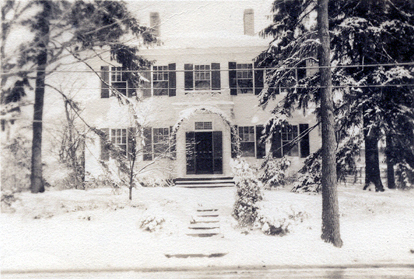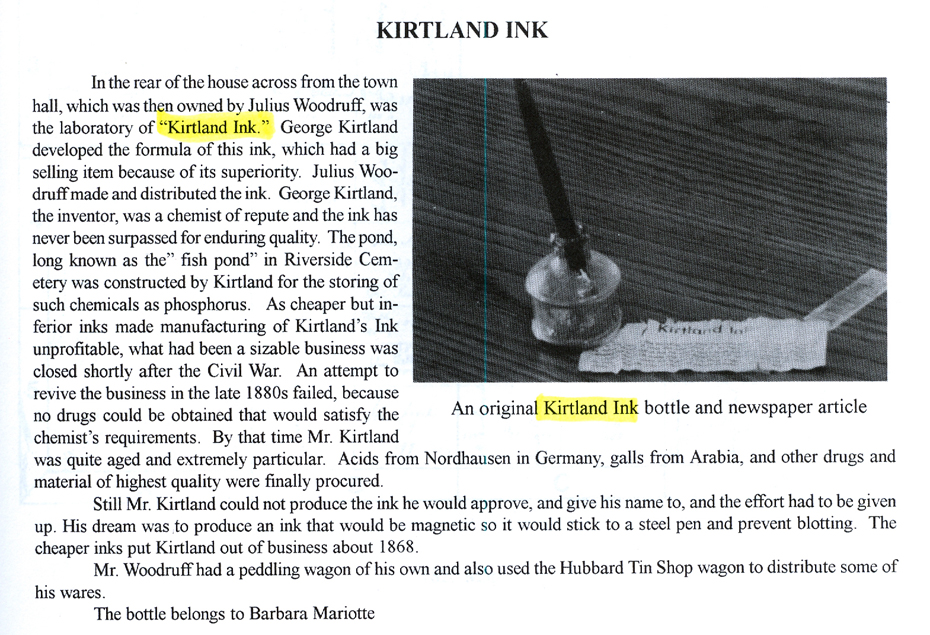|
About George Kirtland
By Edward Kirtland Hine, Jr. ("Ted", 2nd Great Grandnephew) -
November 2013
| |
 |
The
large home that George Kirtland had built in 1845
at 441 South Main St, Poland, OH. This photo is from
the 1930's when the home would have been around
90 years old. |
George Kirtland was a son of Turhand
Kirtland (founder of Poland, OH) and brother of my 2nd great
grandfather Billius Kirtland. He was born on November 05, 1809
and died at the age of 81 on September 15, 1890. He's buried in
Poland's Riverside Cemetery. He likely spent his entire life
living in Poland, OH. He married Helen Cook and had two
children, Mary Potter Kirtland (who died in infancy) and William
Potter Kirtland (who passed away at age 30 and for who I show no
marriage or children). George and Helen were apparently
divorced at some point. An 1840 Poland Township map shows that
George owned 143.5 acres of land in the township, likely given to
him by has father.
George Kirtland is notable for two reasons.
First, in 1845 he built a large home at 441 South Main St. in Poland,
possibly using proceeds from his share of his father's estate
(Turhand having passed away in 1844). He sold this home
to Samuel Hine in 1864 and this is where Samuel and
George's niece Emma Kirtland-Hine would raise their 5 children.
This home, today beautifully restored and on the National Register
of Historic Places, was in the
Kirtland and Hine families for 110 years till the death of Samuel
and Emma's daughter Nell in 1955.

Second, George, apparently
among other ventures, invented Kirtland Ink which was
popular and widely distributed in the mid 1800's in the days before
today's ubiquitous ball-point pens were invented and when a pen
needed to be dipped in ink after every few strokes. George's
ink was apparently quite popular until competitive
pressures forced it off the market, coincidentally around the time
he sold his large home to Samuel Hine and moved next door to a
smaller one. Today antique Kirtland Ink bottles can
occasionally be found for sale on internet auction sites as
collectors items. It can be assumed that George did well
financially, at least for a time, since he could afford to have
built and
live in the large Kirtland/Hine home for almost 20 years.
 |
|
From the publication
"Township One, Range One, Poland, Ohio - Our Western
Frontier" (1996) |
The above indicates that George's ink formula
was manufactured and distributed by Julius Woodruff. I note
that Samuel Hine's son from his first marriage to Ellen
Montgomery-Hine, Cecil Dwight Hine, married Elizabeth Woodruff who
was from Poland. I suspect that she was likely related to
Julius but haven't figured out how. (Elizabeth's father was
George Woodruff but Julius could have been her brother or uncle.)
|
Two antique
Kirtland Ink bottles purchased by my brother Henry
in the early 2000's on the internet. |
The following is some information regarding
George that I've run into while researching my Ohio ancestors.
From "A Look At Poland, Ohio - 200 Years and Counting" page 7 by Robert Wilkeson
(1996):
"George Kirtland, son of Turhand Kirtland, was born on November 5, 1809. He
married Helen Cook and they had two children, Mary and William Potter. George
engaged in farming and the manufacture of ink. In 1843, George Kirtland was one
of the co-founders of the iron foundry on Yellow Creek. His house is located at
441 South Main Street. It was built in 1845, and is marked with an Ohio State
Historical marker. The house is across South Main Street from the Presbyterian
Church. George Kirtland died on September 15, 1890 in Poland, and is buried in
Poland's Riverside Cemetery."
 |
While hard to read, "Kirtland" is written across to very top
portion of this bottle and Woodruff on the left at the bottom.
(Photo captured from an internet auction site.) |
From "Guidebook to Historical Sites and Points of Interest In Poland, Ohio"
regarding the home at 441 South Main Street:
"The George Kirtland-Hine House, built ca. 1845 in the Greek Revival style
for Turhand Kirtland's fourth son George. When George's marriage failed, his
niece Emma, Mrs. Samuel Hine, occupied the house and George moved next door. The
house is notable for its flush board siding and elaborate Ionic portico. The top
of the portico once had a carved wooden balustrade made to imitate cast iron.
The interior woodwork, arches and fireplaces of the front parlors are intact."
Nell Hine's Recollections
of Her Uncle George
George's niece, Ellen Louis Hine ("Nell")
talks about her uncle George in a manuscript she wrote in the mid
1940's.
On page 2 of "The Billius Kirtland Family"
she writes after discussing other paintings: "I have Uncle George
Kirtland's portrait by a better artist. It hangs above our 66
year old piano in the green sitting room. Our house was built
by , or for, Uncle George Kirtland. My impression is that
great grandfather, Turhand Kirtland, had a home built for each
child. Uncle George was handsome but when I showed him his
portrait, when he was an old man, he looked at it and remarked, "Did
I ever look like that! I remember when the portrait was shown
to me, I was so disgusted, I threw I across the room."
Nell continues: "Uncle George's
appreciation of the Hine children's singing on Sunday afternoons,
when Mother played, was more thrilling to him than any other mortal
as he said, 'We should travel.'"
"His life was an example of how the green
monster jealousy can wreck lives. When Uncle George was a
young man, he visited in Wallingford, Conn., the home of his
ancestors. He had become acquainted with a number of girls and
was about to leave for home when the Episcopal Rector of the Church
spoke to him about marrying his daughter, Helen. Uncle was not
aware he had been more attentive to her than the others, but they
were married and came to Poland to live, and visited
Grandmother, Ruthanna."
"They had two children, the younger, Mary,
is buried by her father in the new Cemetery. Aunt Helen went
east with her son to visit but her son was drowned, and I imagine,
due to jealousy, Uncle George never sent for her, and later she
married. She kept in touch with Cousin Lucy Boardman."
"Uncle George discovered making fadeless
ink. He also had a knitting machine and a swamp where he
raised huckleberries."

|